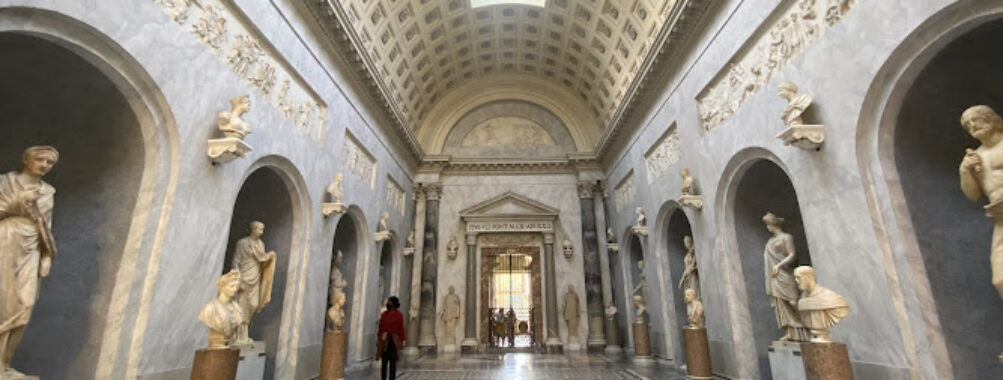
Braccio Nuovo
“`html
Table of Contents
Description
The Braccio Nuovo, or “New Wing,” inside the Vatican Museums is one of those places that quietly takes your breath away. Built in the early 19th century under Pope Pius VII, it was designed to house the flood of ancient sculptures that had been returned to Rome after Napoleon’s forced relocations. The architect Raffaele Stern began the project, and after his passing, it was completed by Pasquale Belli. Today, it feels less like a sterile museum hall and more like a grand stage where history itself is performing. The long, barrel-vaulted gallery is lined with statues, busts, and reliefs that tell stories of emperors, gods, and mythological figures. You walk through and it’s almost like they’re watching you back.
What makes this gallery stand out is its balance of grandeur and intimacy. It isn’t the most crowded section of the Vatican Museums (thankfully), yet it contains some of the most striking sculptures you’ll ever see—like the colossal statue of Augustus of Prima Porta or the portraits of Roman emperors that seem to carry their personalities across centuries. Some visitors rave about the atmosphere, calling it a highlight of their Vatican trip, while others feel it’s “just another gallery” in the vast museum maze. Honestly, it depends on your mood and how much gas you’ve got left in the tank after the Sistine Chapel and Raphael Rooms. But if you’re an art or history lover, this wing is pure gold.
It’s also worth pointing out that the Braccio Nuovo is quite accessible. Wheelchair users can find restrooms nearby, and the broad, level corridor makes navigation easier compared to some of the older sections of the museums. Families with kids often appreciate that it’s not overwhelming in size, so younger travelers can enjoy the statues without getting restless. Personally, I found it a refreshing pause in the Vatican Museums marathon—quiet enough to breathe, but still packed with treasures that make you stop in your tracks.
Key Features
- Designed by Raffaele Stern and completed in 1822 under Pope Pius VII
- Houses celebrated Roman sculptures, including the Augustus of Prima Porta
- Long barrel-vaulted hall with natural light highlighting marble details
- Portrait busts of emperors and philosophers arranged in classical order
- Accessible restrooms and wheelchair-friendly layout
- Less crowded compared to other Vatican highlights, offering a calmer experience
Best Time to Visit
Timing really makes or breaks your visit here. The Vatican Museums in general are busiest in the late morning and early afternoon, especially during high season (spring and summer). If you want to enjoy the Braccio Nuovo without being elbow-to-elbow, aim for early morning right after the museums open. I once went in around 9 a.m., and the hall felt almost private—just me, a few other travelers, and rows of ancient faces staring back. Late afternoons can also be good, though you’ll feel a bit of museum fatigue by then. Winter months are quieter overall, so if you’re not tied to a summer vacation, that’s a sweet spot.
How to Get There
The Braccio Nuovo is located inside the Vatican Museums, so your journey starts with getting a ticket to the museums themselves. Tickets often sell out, so booking ahead online is strongly recommended. Once inside, you’ll find the New Wing as part of the Museo Chiaramonti, connecting the Courtyard of the Pinecone (Cortile della Pigna) with the Belvedere Courtyard. If you’re like me and tend to get lost in large museums, don’t stress—there are clear signs, and staff are usually helpful in pointing the way. Public transport in Rome makes reaching the Vatican straightforward: the Ottaviano metro stop (Line A) is about a 10-minute walk from the entrance. Buses and taxis also drop you close by, but honestly, walking through the surrounding Borgo neighborhood is half the fun.
Tips for Visiting
A few practical tips can make your visit smoother and more enjoyable. First, wear comfortable shoes. The Vatican Museums are huge, and by the time you reach the Braccio Nuovo, your feet will thank you for good support. Second, give yourself permission to slow down here. A lot of visitors rush through on their way to the Sistine Chapel, but the New Wing deserves at least 20–30 minutes of your attention. Try standing in the middle of the hall and just soaking in the symmetry—it’s oddly meditative.
Photography is allowed (without flash), so bring a camera or your phone, but remember that some of the best memories come from simply looking, not snapping. If you’re traveling with kids, point out the different facial expressions on the busts—it’s like a fun guessing game about who looks grumpy, wise, or mischievous. For accessibility, know that elevators and ramps are available, though they may take a bit of extra navigation, so allow time. And here’s a personal tip: if you’re visiting in summer, carry a small bottle of water. The Vatican Museums can get warm, and while there are restrooms nearby, water fountains aren’t always easy to spot.
Lastly, keep in mind that the Braccio Nuovo is part of a sacred and cultural institution. Dress modestly (shoulders and knees covered), and bring a bit of patience. The payoff is worth it—standing in that long hall, surrounded by centuries of history, you’ll feel like you’ve stepped into a dialogue between past and present. And honestly, that’s the kind of travel moment that sticks with you long after you’ve left Rome.
“`
Location
Places to Stay Near Braccio Nuovo
Find and Book a Tour
Explore More Travel Guides
No reviews found! Be the first to review!